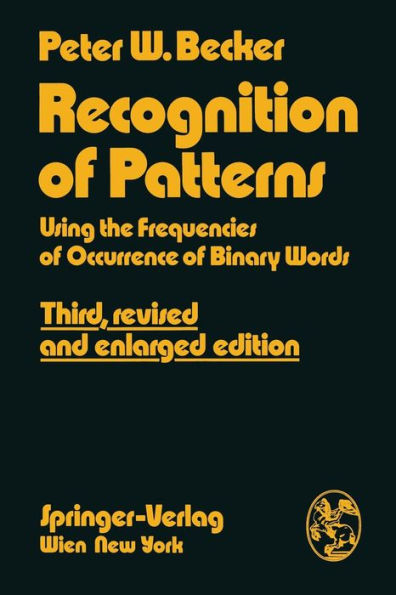Recognition of Patterns: Using the Frequencies of Occurrence of Binary Words
This book is a revised updated edition of the second edition which appeared 1974.The work described in this publication was initiated at the General Electric Company's Electronics Laboratory, Syracuse, N.Y., U.S.A. The author would like to take this opportunity to express his gratitude to the Electronics Laboratory for its support and encouragement in this work. Thanks are in particular due to Dr. J.J. Suran for his continued interest and help. It is impossible to acknowledge all the help the au thor has received from members of the Laboratory staff. However, the au thor is particularly indebted to r·lr. T.C. Robbins for managing the build ing of the word recognizer (described in Section 7.4) and for many helpful discussions. The work was later continued in Denmark, supported by two grants: no. 1382 in 1966 and no. 1511 in 1967, received from the Danish Govern ment Fund for Industrial and Scientific Research. The author is grateful to said Fund, and thereby the Danish taxpayers, who gave the author an opportunity for uninterrupted work with pattern recognitions problems. In August 1967 the author joined the staff of the Electronics Labo ratory, Technical University of Denmark, where the subsequent pattern recognition work took place; the author is happy to acknowledge his debt to the members of the staff and to his students for many stimulating and helpful discussions.
"1012939463"
Recognition of Patterns: Using the Frequencies of Occurrence of Binary Words
This book is a revised updated edition of the second edition which appeared 1974.The work described in this publication was initiated at the General Electric Company's Electronics Laboratory, Syracuse, N.Y., U.S.A. The author would like to take this opportunity to express his gratitude to the Electronics Laboratory for its support and encouragement in this work. Thanks are in particular due to Dr. J.J. Suran for his continued interest and help. It is impossible to acknowledge all the help the au thor has received from members of the Laboratory staff. However, the au thor is particularly indebted to r·lr. T.C. Robbins for managing the build ing of the word recognizer (described in Section 7.4) and for many helpful discussions. The work was later continued in Denmark, supported by two grants: no. 1382 in 1966 and no. 1511 in 1967, received from the Danish Govern ment Fund for Industrial and Scientific Research. The author is grateful to said Fund, and thereby the Danish taxpayers, who gave the author an opportunity for uninterrupted work with pattern recognitions problems. In August 1967 the author joined the staff of the Electronics Labo ratory, Technical University of Denmark, where the subsequent pattern recognition work took place; the author is happy to acknowledge his debt to the members of the staff and to his students for many stimulating and helpful discussions.
109.99
In Stock
5
1

Recognition of Patterns: Using the Frequencies of Occurrence of Binary Words
222
Recognition of Patterns: Using the Frequencies of Occurrence of Binary Words
222Paperback(Softcover reprint of the original 3rd ed. 1978)
$109.99
109.99
In Stock

Product Details
| ISBN-13: | 9783211815069 |
|---|---|
| Publisher: | Springer Vienna |
| Publication date: | 12/11/1978 |
| Edition description: | Softcover reprint of the original 3rd ed. 1978 |
| Pages: | 222 |
| Product dimensions: | 5.98(w) x 9.02(h) x 0.02(d) |
From the B&N Reads Blog
